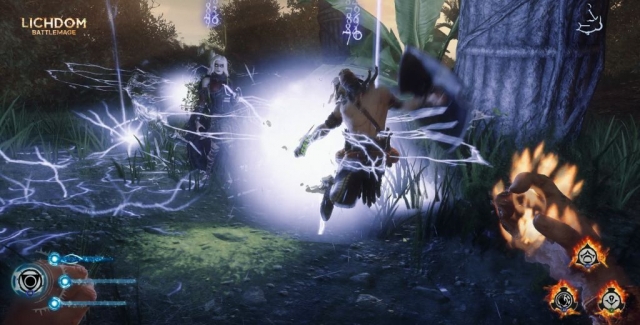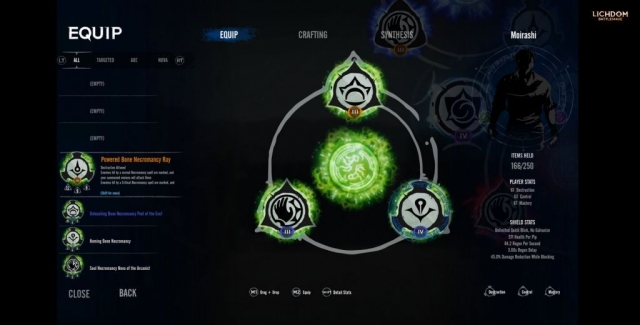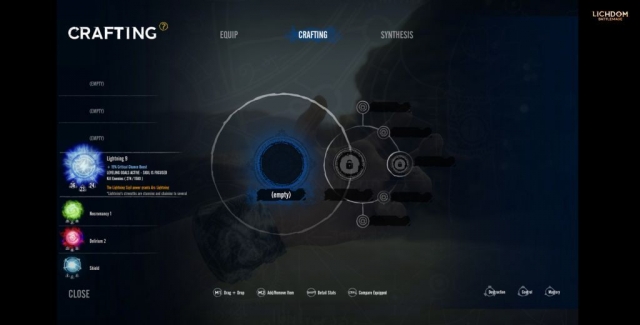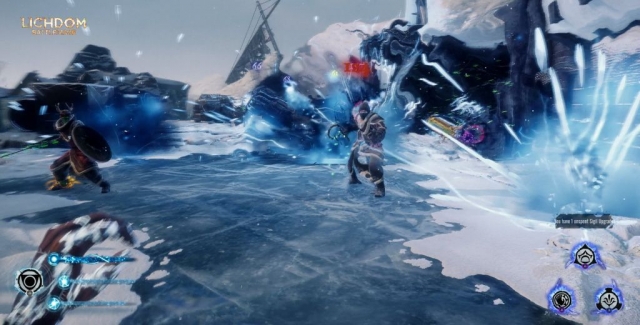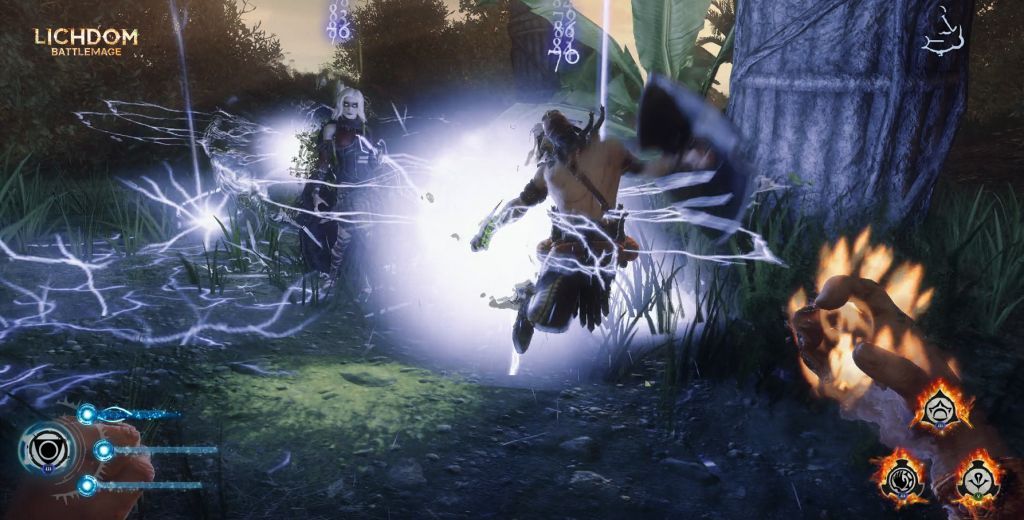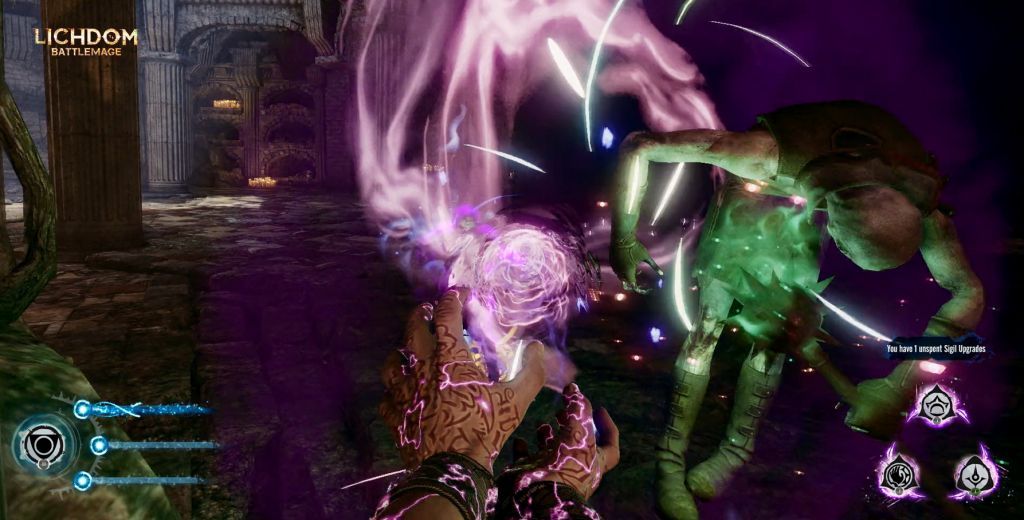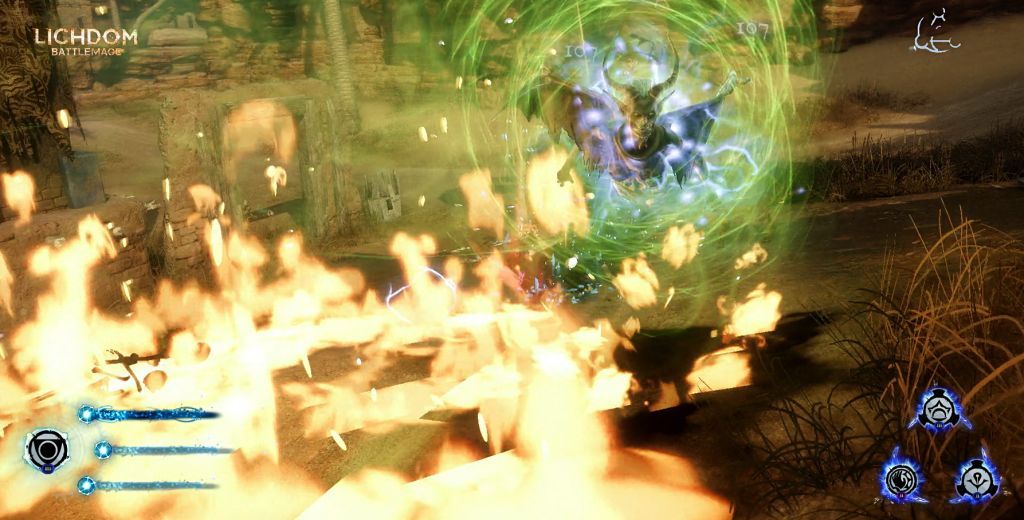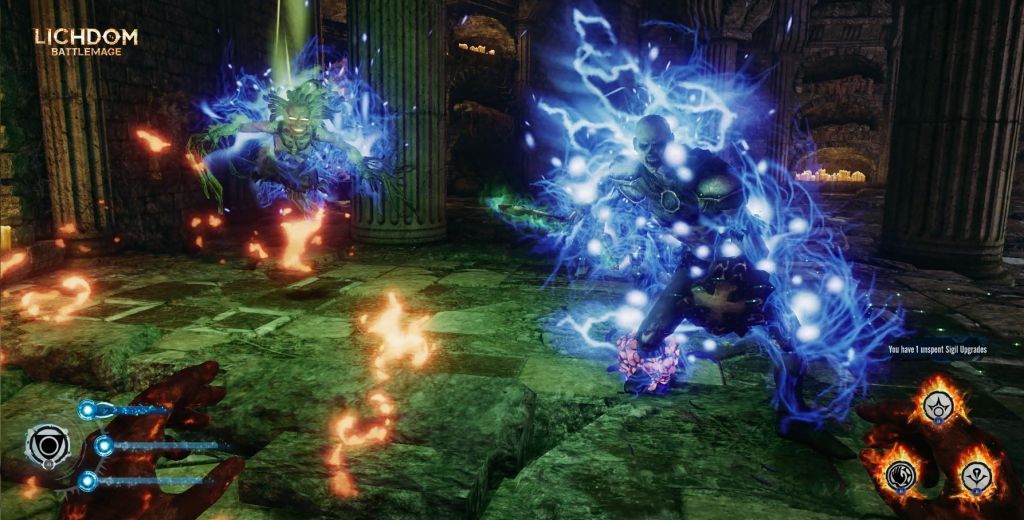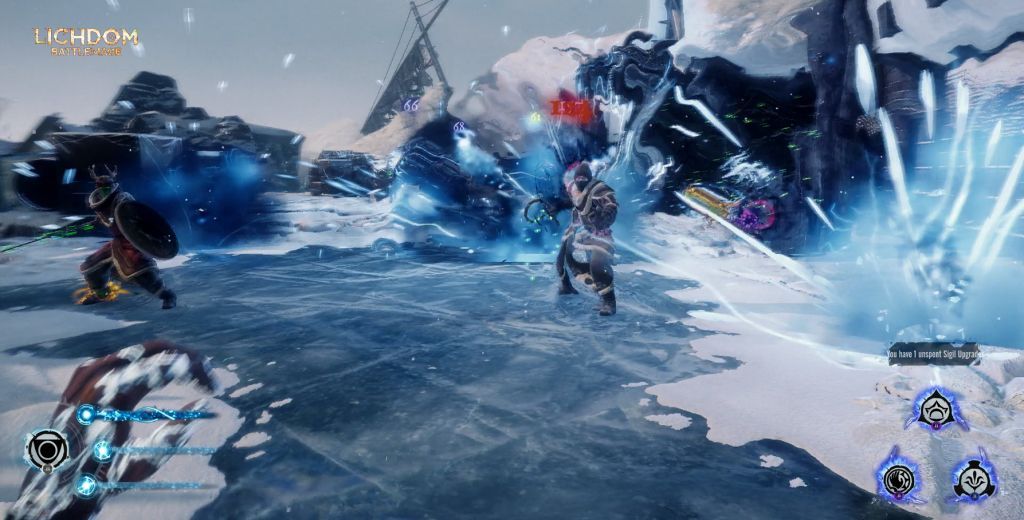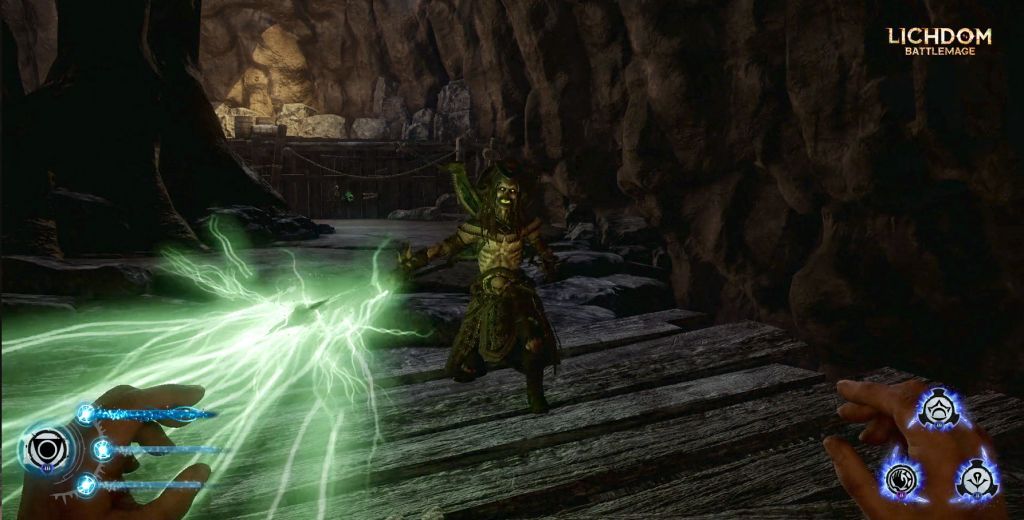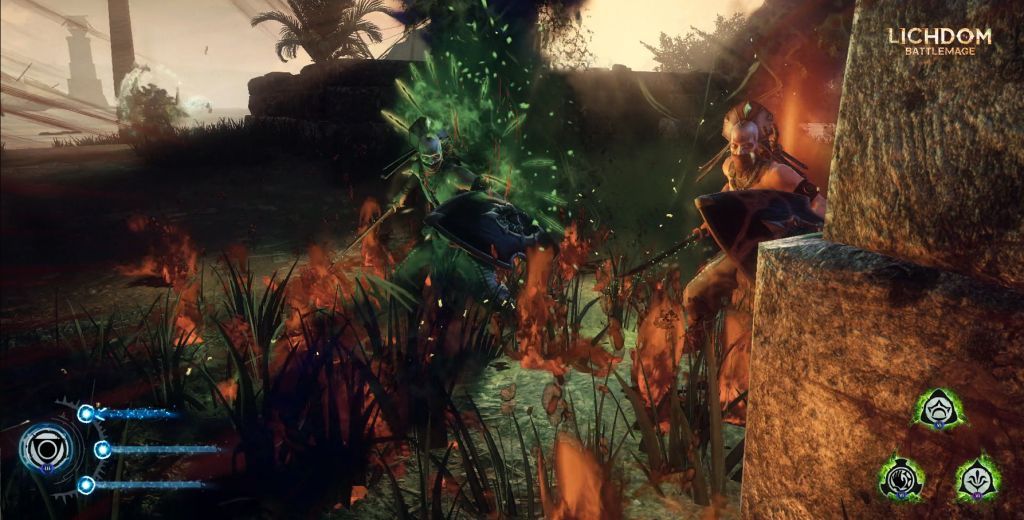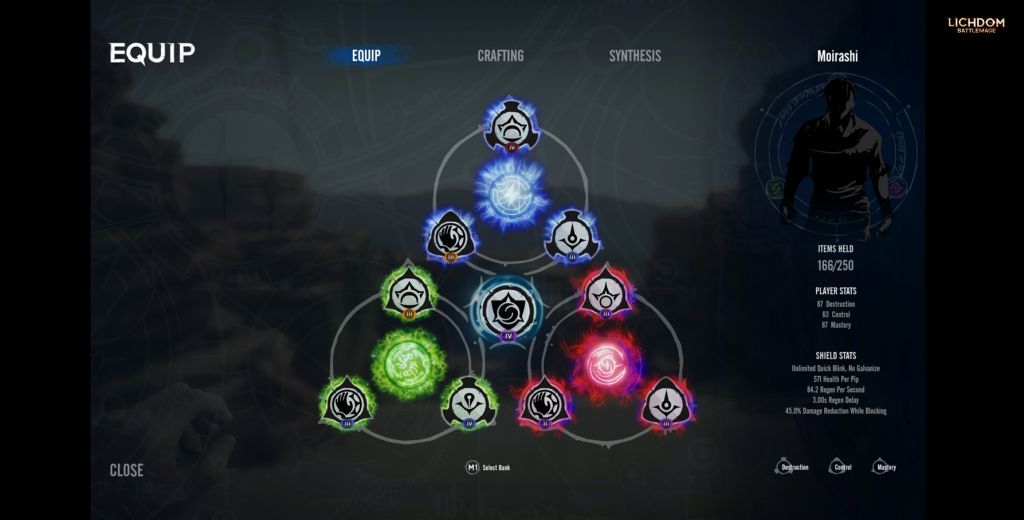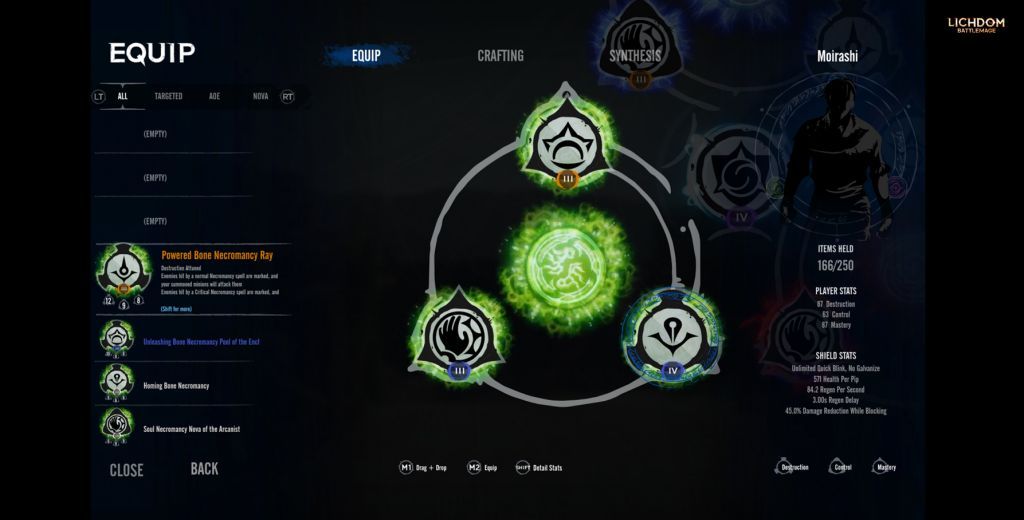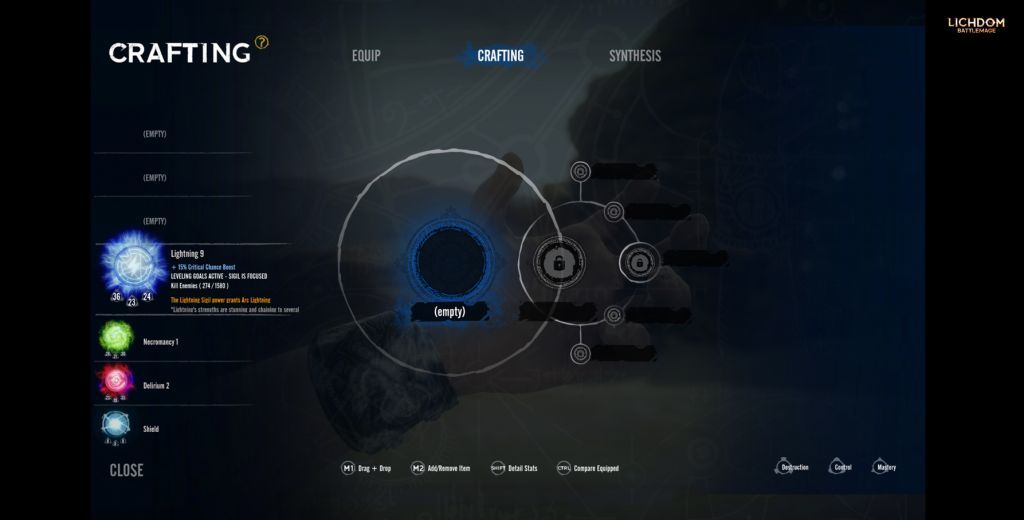Lichdom: Battlemage
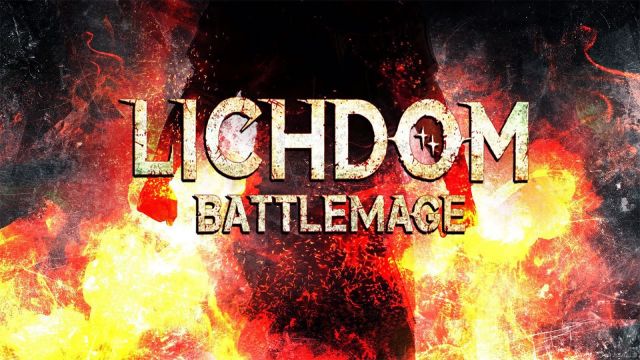
The Good: Cool graphics, especially for spellcasting. Clever control scheme.
The Bad: Highly linear, scripted adventure. Enemy AI gets snagged up on the landscaping with some frequency.
The Ugly: Wow, this game could use a manual, or at least a spell creation wiki.
I should probably begin with some kind of disclaimer, because when I play RPGs, even action RPGs, I typically play as a thief. Sneaking around, backstabbing (I don’t play under the nick Backstabber for nothing) is really my style. I’m impatient with mages and their ilk, the slow accumulation of mana or whatever magic fuel the game uses, the perpetual pausing while waiting for spells to recharge. Not my thing. So I was cautious in my approach to Lichdom: Battlemage, which claims to buff up the action of a mage adventure by removing mana and spell cool downs entirely. It succeeds, to some extent, but remains a game in which your goal is to hang back as far as possible and hurl spells at your enemies, which blunts some of the action, though several boss battles liven things up a bit. Also on the downside, it suffers from extremely linear, almost claustrophobic levels, made up entirely of tightly scripted encounters. It also possesses one of the most intricate and confusing spell crafting systems I’ve ever experienced, so confusing in fact that I’m kind of hesitant to try and explain it to you, but that’s what they pay me the big bucks for, so here goes.
To start with, you can play the game as either a man or a woman – having gone into the game a fair ways with both it seems that the difference is entirely cosmetic. Both origin stories are, whew, kind of drama queen. The woman story, for example, is that you’re a jeweler in your store one day giving a gift to your sister; a necklace of some kind. A man comes in and wants to buy that very necklace right off your sister’s neck. You inform him it is not for sale, and he decides to take your sister instead, and beat you up, and though you don’t see it happen he probably twirls the end of his waxed moustache villainously and then takes your sister and ties her to either train tracks of a buzz saw, whichever is handier. Evil much? You of course vow revenge. Oh, and separately he comes back with some cult and casts a spell of laziness on your entire town. Here the plot gets a little metaphysical, because it seems that something like this has happened in the distant past, and a guy named Roth shows up and names you Dragon, the person who shall defeat this evil. Whichever character you choose not to play is named the “Griffin” and they are tasked with helping you in this fight. Don’t get your hopes up for significant NPC assistance. Help in this case is limited to appearing from time to time, saying something snarky, giving some possibly useful intel (“There’s an ambush up ahead.”), or talking about some big fight they just engaged in that you didn’t see, and then disappearing again.
Roth also introduces you to the world of magic, Lichdom style. Even after fifteen or so hours of playing, there are still a lot of pieces of it that I haven’t made much sense of, but here is what I do know: Magic in Lichdom is divided into eight schools (they’re called sigils in the game). Sigils are, for example, fire, ice, electricity, kinesis, sort of the raw forces of magic. You start with a single sigil (fire) and new sigils are added at key game plot points. Sigils also level up as you use them, though what exactly constitutes use or how you earn points towards leveling is not exactly clear to me.
The elements of a spell are a sigil, a shape, and one or several augments. Augments and shapes you pick up as glowing spheres. Most creatures that die drop one, and there are caches of them hidden around the map, and bosses drop lots of them. Augments and shapes come in dozens if not hundreds of flavors. Firstly, augments and shapes have a rarity to them – common, uncommon, rare, epic(?), maybe some other levels. The rarer the augment, the more powerful it is. Secondly they have a focus. Shapes of spells can be trap, missile, lob, area, shield, and others. Augments can be defense, destruction, control, mastery, and on and on. So you can combine a fire sigil with a lob shape and a destruction augment to make a kind of fireball spell. Or you can put together electricity with area and control to create a small electrical storm.
Still with me? Good, because there’s more. Common augments and shapes can be combined to make uncommon ones (3 for 1). If you combine three ray shapes you get a rarer ray shape. If you combine two of one type and one of another, you get the majority type. If you combine three different shapes or augments, I have no idea what rules guide the outcome, but at least you get to see what you’re creating before you decide to actually go through with the combination. It maybe also appears that combining three of the same type of piece gets you a more powerful piece (more buffs) in the outcome. You can then combine 3 uncommon pieces to make a rare one, and on up the food chain, though some seem to “top out” eventually, allowing no further combining, for reasons that are not clear. It is also possible to later break them apart, but you only get to salvage one of the three components. Mixing and matching and experimenting with them is clearly something the game makers want you to play with, a lot.
The combining, de-combining, spell-making tool is just a big scrollable list down the left part of the screen with target circles to drag and drop the components into as you build. The list can be isolated to just shapes or just augments, but it’s not well-sorted. Maybe it is intended to be by order of rarity, though that doesn’t work perfectly. It also isn’t perfectly ordered by type, meaning lob shape components will mostly appear together, but they’ll sometimes be caught elsewhere in the list. Given that the game (at present patch) allows you to store up to 250 of these pieces, you can spend a lot of time scrolling up and down the list just to familiarize yourself with what spell components you have available to you. Then when you create a spell, it has all kinds of stats beyond simple damage caused and casting time, like mastery and critical percentages, and I’m never sure if I’ve created a better spell beyond simply comparing damage numbers because the other stats are never explained. Is it better to have high mastery or high critical? I don’t know.
So how does all this play out? The game allows you to keep three sigils active at any one time. You can shuffle which ones are active at checkpoints, which also function as the save game points. Lichdom, like many others that use this fixed save point system, has the problem that some save points are very close together, and others are very far apart, forcing you to replay big pieces of the game if you die. I will give them credit in that at least right before a big boss battle, there is always a save point. Each spell has three effects. The right mouse button is a shaped spell like a missile or lob or ray, and it can be held down to supercharge a spell before releasing it. The left mouse button is a shield which blasts sigil energy if your opponent strikes when it is active. This is pretty easy to do; the shield timing is not particularly twitchy at all. Finally holding down both mouse buttons gives an area effect spell, and it too can be supercharged prior to release. So with a pretty simple control scheme they do manage to give you a wide range of spell effects and I like that I can have a fire spell that is a missile or a ray or a burning pool or a rain of fire with just minor tweaks to the spell elements, all conveniently castable at my fingertips.
The game map is almost entirely a single, linear trail consisting of narrow hallways which connect larger areas where the encounters happen. Occasionally a branch leads off to a bonus room where a miniboss battle takes place which pays off in some rare and valuable augments and shapes, but beyond that you’re adventuring on rails. The encounters are heavily scripted, with the same enemies jumping out of the same hiding places. Overall the cadence of the game is very predictable, and it allows you to walk into combat with a supercharged spell at the ready. Spell charging takes a little bit of time (a second or two), and I found myself often advancing into a room to activate the enemies, then backing up into the hallway, which serves the dual purpose of luring them into a choke point to maximize the effectiveness of area spells as well as giving me time to charge up the spells while backpedaling. So, while Lichdom may have been reaching for a battlemage flavor, what it achieved IMHO is more cowardly by design.
Still, the game is not without its charms. There are many different enemy types with some skills of their own (the archers in particular can be quite deadly), though they do get stuck on terrain features and each other when they’re frozen with some frequency, especially the big bosses. The spell effects are varied and beautifully drawn; guys burst into flames or come down with pus-filled consumption boils or crumble into a million tiny ice crystals. Combining sigil attacks, such as freezing an enemy solid and then blasting them with fire, increases the damage you do. I stumbled upon a freezing lob attack which shatters into smaller ice balls upon impact (don’t ask me what combination of spell components got me there; I have no idea) which freezes everything it touches. I used it frequently to freeze entire groups of enemies in place which I would then follow up with a flaming meteor blast that would turn them all into screaming human torches and then ashes. Good stuff!
With some kind of expansive manual, or a burning desire to try absolutely every augment with every other, perhaps I could have discovered the underlying mechanics that make up spell creation and come up with some really neat spells. As it is, sort of slapping together the most powerful spell components to create a spell, and then see how I liked it was kind of random and felt frustrating. The tutorials are nothing more than little movies that show you how to cast spells, but not really how to make them. I am waiting for the Lichdom wiki to become less rudimentary than it is today to see what others have figured out. But even if the spell creation had been perfect and as pretty as much of the graphics are, the adventure is just too scripted and too predictably paced, and the combat is too backpeddally to recommend highly.
Reviewed By: Phil Soletsky
Publisher: Xaviant
Rating: 70%
——————————————————————————–
This review is based on a digital copy of Lichdom: Battlemage for the PC provided by Xaviant.
 Game Over Online
Game Over Online